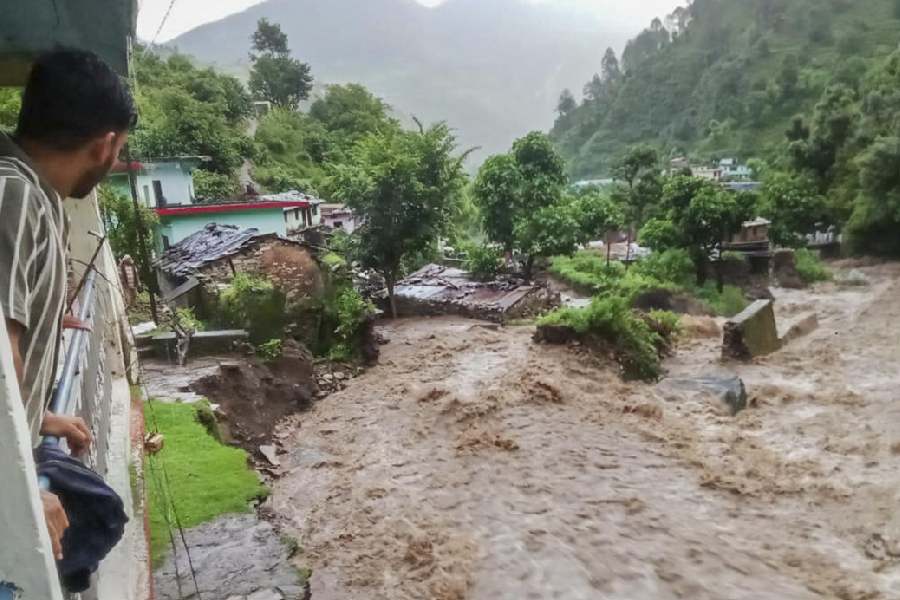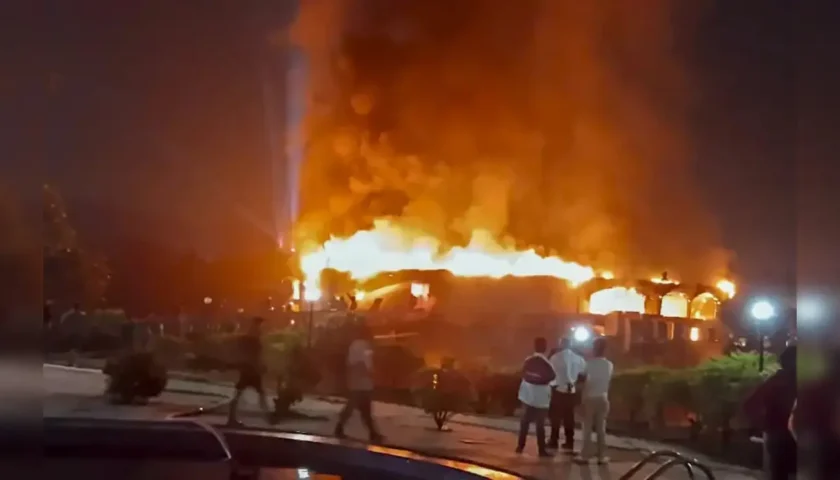Woman buried under debris, man missing as cloudburst hits Uttarakhand’s Chamoli
By: Javid Amin | 22 Aug 2025
Nature’s Fury Returns to Uttarakhand
Once again, Uttarakhand—the land of rivers, mountains, and sacred pilgrimages—has been shaken by the unpredictable wrath of nature. A cloudburst in Tharali tehsil of Chamoli district left behind a trail of devastation, reminding us how fragile life in the Himalayan region can be.
According to officials, a 20-year-old woman named Kavita was buried under debris, while a man named Joshi is reported missing. The calamity struck late at night, catching families unprepared. Debris and floodwaters entered multiple homes, including the residence of the Sub-Divisional Magistrate (SDM).
By morning, visuals told the grim story:
-
Houses and roads partially destroyed.
-
Trees uprooted.
-
Vehicles buried under mud and rubble.
Relief operations by the National Disaster Response Force (NDRF) and State Disaster Response Force (SDRF) began overnight. Still, officials like Chamoli DM Sandeep Tiwari warned that the scale of damage may be much larger than initially reported.
This disaster comes just weeks after a cloudburst in Uttarkashi, which triggered flash floods and left over a hundred people missing. For Uttarakhand, these are no longer isolated tragedies—they represent a pattern of escalating extreme weather events.
What is a Cloudburst? Understanding the Phenomenon
To truly grasp the scale of the tragedy, we need to understand what a cloudburst is.
-
Definition: A cloudburst is an extreme rainfall event, where more than 100mm of rain falls within an hour over a small area.
-
Impact: Such intense rainfall overwhelms natural drainage, causing flash floods, landslides, and debris flows.
-
Why Dangerous in Himalayas:
-
Steep slopes accelerate water flow.
-
Fragile mountain soil cannot absorb excess rain.
-
Human settlements along rivers and roads are highly vulnerable.
-
Science Behind It
Cloudbursts are often linked to orographic lift—when moisture-laden monsoon winds hit mountains, rise rapidly, and condense into intense rain.
With climate change, rising global temperatures are increasing atmospheric moisture, making cloudbursts more frequent and intense.
The Chamoli Incident: A Timeline of Events
-
Night of the Disaster
-
Heavy rainfall lashed Tharali tehsil.
-
Around midnight, a cloudburst struck Dharali village, releasing torrents of water and debris.
-
-
Immediate Impact
-
Debris and floodwaters entered homes, including the SDM’s residence.
-
Several houses were damaged, vehicles and trees uprooted.
-
Kavita, a 20-year-old woman, was buried under debris.
-
Joshi, a local resident, went missing.
-
-
Morning After
-
Visuals showed mud-filled streets, broken walls, and displaced families.
-
NDRF and SDRF teams were deployed overnight.
-
Authorities began road clearance and rescue operations.
-
-
Official Statements
-
Chamoli ADM Vivek Prakash confirmed casualties and damage.
-
Disaster Management Secretary Vinod Kumar Suman said debris entered homes and markets.
-
Chamoli DM Sandeep Tiwari hinted at significant damage yet to be assessed.
-
Human Impact: Lives Interrupted, Dreams Shattered
Victims and Families
-
Kavita (20 years old): A young woman with her life ahead of her, lost suddenly to nature’s fury.
-
Joshi (missing): His family clings to hope as rescue teams continue their search.
These names remind us that beyond statistics, each disaster is deeply personal.
Community Impact
-
Dozens of families displaced.
-
Loss of homes, livestock, and small businesses.
-
Villagers struggling without electricity, clean water, and road connectivity.
Emotional Trauma
Survivors describe a night of horror—walls trembling, water rushing in, children crying, families running in panic. The psychological scars of such disasters linger long after physical rebuilding begins.
Uttarakhand’s Vulnerability: A Region Under Siege
Uttarakhand is often called “Devbhoomi” (Land of the Gods), but in recent years it has also become a hotspot for natural disasters.
Major Past Disasters
-
2013 Kedarnath Floods: Thousands killed in one of India’s worst natural calamities.
-
2021 Chamoli Glacier Burst: Flash floods destroyed hydropower projects and killed over 200 people.
-
2023-24 Series of Cloudbursts: Uttarkashi, Rudraprayag, and Chamoli faced recurring floods.
Why So Vulnerable?
-
Geography: Steep Himalayan terrain, fragile soils.
-
Climate Change: Intensifying monsoon patterns.
-
Unplanned Development: Roads, dams, and urbanization without ecological safeguards.
-
Deforestation: Reduced natural barriers against floods.
Role of Climate Change: The Bigger Picture
Scientists increasingly warn that climate change is amplifying extreme rainfall events like cloudbursts.
-
Rising global temperatures = more water vapor in atmosphere.
-
Himalayan glaciers are melting, altering river dynamics.
-
Monsoon systems are becoming erratic.
A 2021 IPCC report highlighted that the Himalayas are warming twice as fast as the global average—making Uttarakhand particularly vulnerable.
Relief & Rescue Operations: On the Ground
Agencies Involved
-
NDRF (National Disaster Response Force)
-
SDRF (State Disaster Response Force)
-
Local Police and Administration
Actions Taken
-
Overnight deployment of rescue teams.
-
Search for missing persons.
-
Road clearance with bulldozers.
-
Temporary shelters for displaced families.
Challenges
-
Roads blocked by debris slowed relief work.
-
Continuous rain increased risk of fresh landslides.
-
Remote locations made communication difficult.
Weather Alerts and Preparedness
The India Meteorological Department (IMD) has issued an orange alert for Uttarakhand.
Forecast Highlights
-
Very intense rain with thunderstorms and lightning.
-
Districts under high risk: Dehradun, Tehri, Pauri, Uttarkashi, Chamoli, Rudraprayag, Nainital, Almora, Udham Singh Nagar.
-
Towns & religious sites: Kedarnath, Gangotri, Joshimath, Mussoorie, Rishikesh, Kotdwar, Pithoragarh, Lohaghat, Ranikhet, Khatima.
Preventive Measures
-
Schools shut in Pithoragarh and vulnerable areas.
-
Authorities asked residents to stay alert for landslides and flash floods.
Voices from the Ground: Stories of Courage and Loss
-
Local Villager: “We woke up to screams and rushing water. By the time we stepped out, the debris had already entered our homes.”
-
Rescue Worker: “Our teams worked all night in dangerous conditions. The priority is to find the missing and protect the survivors.”
-
Official (Chamoli DM): “There is a possibility of significant damage. Assessment is ongoing.”
These testimonies reflect both the fear and resilience of people living in disaster-prone Himalayan regions.
Policy and Governance: What Can Be Done?
Current Measures
-
Deployment of disaster response teams.
-
Real-time weather alerts by IMD.
-
Infrastructure fencing and retaining walls in some areas.
What More is Needed?
-
Better Early Warning Systems
-
Cloudburst prediction is still limited—requires advanced radar technology.
-
-
Eco-Sensitive Development
-
Restrict construction in vulnerable zones.
-
Promote sustainable tourism.
-
-
Community Preparedness
-
Regular disaster drills in schools and villages.
-
Local task forces trained in first response.
-
-
Climate Action
-
Reduce greenhouse gas emissions globally.
-
Strengthen regional climate adaptation programs.
-
Comparisons: Cloudbursts Worldwide
Uttarakhand is not alone. Similar disasters occur in other mountainous regions:
-
Pakistan (2022): Intense monsoon rains triggered floods affecting 33 million people.
-
Nepal (2014, 2021): Landslides and cloudbursts killed hundreds.
-
Switzerland & Alps: Glacial floods linked to climate change.
The common thread: fragile mountain ecosystems everywhere are under threat from climate-induced extreme weather.
Conclusion: A Wake-Up Call from the Mountains
The Chamoli cloudburst is not just another natural disaster—it is a warning sign. Uttarakhand’s fragile ecology cannot withstand unchecked urbanization and climate change.
-
For victims like Kavita and Joshi, these warnings came too late.
-
For policymakers, the message is clear: balance development with ecology.
-
For communities, resilience must be built into daily life.
As extreme weather events increase, Uttarakhand’s tragedies may soon become India’s broader climate reality. The time to act—for preparedness, sustainability, and climate justice—is now.




